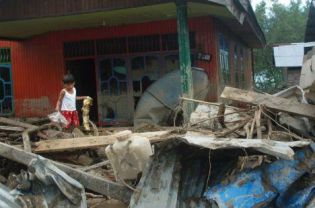 A child pokes through flood debris outside his damaged Wasior home. President Susilo Bambang Yudhoyono will inspect the area on Wednesday. (AFP Photo/Abdul Muin Salawe)
A child pokes through flood debris outside his damaged Wasior home. President Susilo Bambang Yudhoyono will inspect the area on Wednesday. (AFP Photo/Abdul Muin Salawe)
Jakarta. A top government minister on Monday said last week’s flash flood that hit Wasior in West Papua and killed more than 140 people, was not caused by massive illegal logging in the area, but was the result of intense rainfall.
Agung Laksono, the coordinating minister for people’s welfare, told a press conference in Jakarta that there was no large-scale logging in the area.
He said though it was highly likely that some individuals cut down trees in the area without permits, there was no evidence of illegal logging being conducted by a corporation.
“The flood happened because rain of very high intensity poured relentlessly for a few days. The National Meteorology, Climatology and Geophysics Agency [BMKG] has said that extreme weather is to be expected.”
Several environmental organizations have said unchecked illegal logging on the mountains near Wasior was to blame for the flash flood.
Environment Minister Gusti Muhammad Hatta, speaking at the same event, said only around 1 percent of land had been converted in Wasior since 2000, which meant that no major impact had been made on the land as a result of illegal logging.
“I know we can see many logs in Wasior, but they’re probably only for household use,” he said. Gusti said the Wasior area had become unstable after an earthquake on Oct. 4, and this made it unable to withstand the effects of the torrential rain.
President Susilo Bambang Yudhoyono said separately on Monday he would visit Wasior directly to confirm whether or not the flood was triggered by illegal logging. He is scheduled to leave for Wasior on Wednesday and stay there until Friday.
“As far as I’m concerned, the last illegal logging case handled by the police happened not too far from the flood location, but we will see directly at the site,” he said.
Agung said the government was looking for a safe area to relocate the thousands of people who have been left homeless or had houses severely damaged by the flood.
“Currently, the regional government of West Papua and the National Disaster Mitigation Agency (BNPB) are looking for a safe location for a proper new resettlement area,” he said.
Agung said Wasior was not suitable for habitation because of its geographic location, being too near to a forest reservation.
He said West Papua authorities were thinking of building a resettlement south of Wasior, in Raseei, a 30-minute drive from the disaster site.
La Abidin, an Indonesian Red Cross (PMI) official, said on Sunday survivors were forced to seek refuge in damaged homes and buildings because the government had focused more on recovering bodies.
He said the survivors were vulnerable if more floods hit the area.
Agung said the government would immediately start the reconstruction and the rehabilitation program once the emergency response period had ended on October 18th.
He said the government would soon decree that the post-disaster rehabilitation and reconstruction program was the responsibility of all ministries and so they must each set aside part of their budgets for the programs.
As of Monday, 145 people had been found dead while 103 remained missing following the Oct. 4 flash flood.
